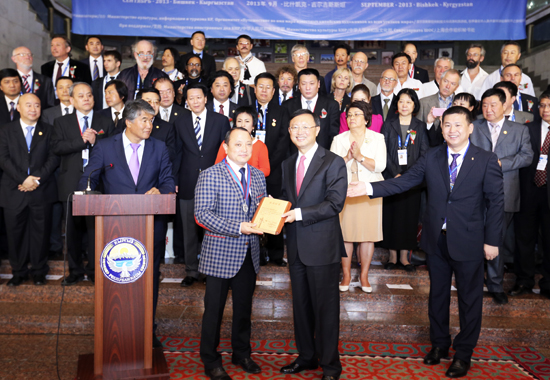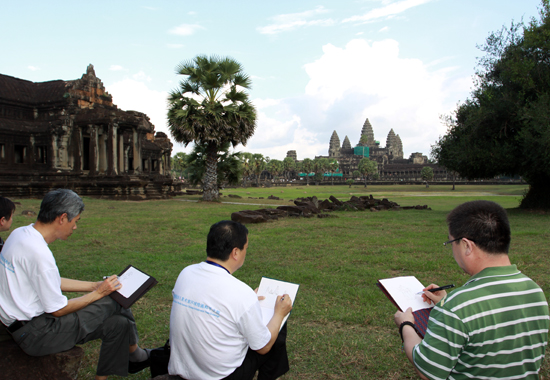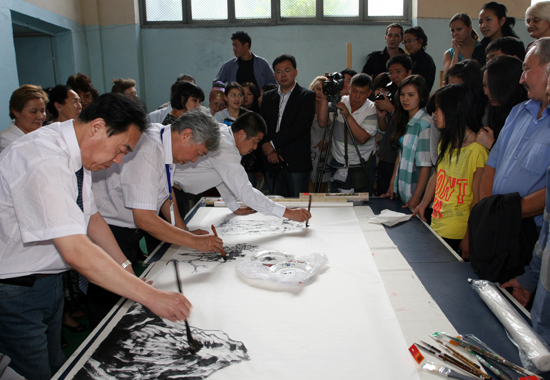Visiting 47 countries and regions in succession, donating materials and goods more than 30 times, holding 20-odd cultural exchange activities on a large scale, signing cooperation agreements with 17 personal funds of heads of foreign countries and research centers, while more than 300 Chinese artists being granted honorary titles of Academician of Art Science Academy, Meritorious Artist, Distinguished Professor and Ambassador of Peace by famous foreign universities and art academies, all of which are the achievements that the Organizing Committee of Global Peace Tour of World-famous Chinese Artists and Beijing Peace Tour Cultural Exchange Center have made over ten years since their foundation.
In the sublime spirit of “Protecting All the Human Cultural Heritages, Promoting Peace and Development of International Society”, it has become one of the major methods of the international cultural exchanges to carry out the friendly exchange and pubic charity with political celebrities, entrepreneurs and artists of all over the world by means of international fine arts exchange. According to the introduction of Mr. Shao Changxun, executive director-general of Peace Tour Cultural Exchange Center and president of Europe-China Cultural and Educational Fund, this successful way of nongovernmental exchange with other countries will make more positive contributions to the promotion of friendly cooperation between China and other countries.
In 2004, Peace Tour made its debut and visited Cambodia with the exchange between Chinese artists and Cambodian art academies. Henceforth, in Russia, Kyrgyzstan Uzbekistan, Laos, Singapore and Kazakhstan, Chinese artists actively participated in the cultural exchange. In 2012 and 2013, the joint exhibitions with the theme of “harmony” and “integration” were successively held in Beijing and Belgium. The forte of Peace Tour in the art exchange grows from strength to strength.
“Fine arts are the best and direct way of communication without explanation in words and can be accepted easily. With the arts as a medium, we can tell our common love for beauty and peace to the people all over the world.” Mr. Shao remarked.
“In painting skills, these artists vary from each other, but we all assume disseminating the ideas of peace as our responsibilities. In this world, to exhibit the truth, goodness and beauty is the mainstream, while those twisted, violent and vilifying works are not welcome in any country.” Mr. Shao explained that those artists who vilified national totems are never accepted into the troupe of Peace Tour. In the meanwhile, he pointed out that lack of discreet choice of artists would not only bring discredit to the cultural image of China in the world, but also affect the trend of Chinese arts in the international art market. “The insane speculation in the art market will influence our art collection in the world, so, we encourage artists to learn good skills and carry out creation with a down-to-earth attitude.”
As an important symbol of Chinese culture, Chinese paining has been well known in the world. In Kazakhstan, the president of Art Science Academy spoke of the Chinese word “Guo Hua” (Chinese painting) with accurate mandarin pronunciation. “They adore the painting skills, color and background of Chinese painting very much and we are proud of the fact that Chinese painting art is esteemed and recognized in foreign countries.” Mr. Shao quoted an example in Moscow that when Chinese artist Shangguan Chaoying draw Chinese painting on the spot, the local audiences marveled at the interplay between the brush, ink, paper and inkstone. When they made a try by themselves, they found it was not easy at all and couldn’t help exclaiming, “How marvelous Chinese painting is!” “We can start with the arts, and then probe into the issues of literature, history, architecture, Fengshui and philosophy. It is our starting point with fine arts as the basis to introduce Chinese traditional culture” Mr. Shao said.
To link the dots in order to form the side, to connect sides to build the solid object, the exchange of Peace Tour is always multi-dimensional with the engagement of national leaders, governments, higher institutions and charity institutions as well. “On this multi-dimensional network, we meet our old friends and pass on the information from China to them and vice versa.”
While reaping great fruits of “going global”, Peace Tour also invites foreign artists to China in a systematic way. “Every year, there are 170 or 180 artists from Italy, France, Egypt, Bengal, Poland, Germany, U.S., Australia, Georgia and Azerbaijan who come to visit China. We organize them to be engaged in the exchange with Fine Arts School of Tsinghua University, Beijing Fine Arts Academy and also introduce them to meet Chinese artists from different regions such as Shanghai, Guangdong, Jiangsu and Heilongjiang. Every foreign artist is an ambassador of Chinese image. When they come back to their own country, they will indulge themselves in publicizing Chinese culture and bring more cooperative opportunities of cultural exchange and business plan to us. We have never dreamed of these effects.”
Different from governmental and commercial institutions, non-profitable folk exchange are easier to be accepted by foreign art institutions and governments. However, there are still dilemmas caused by the related imperfect policies. “We have held an exhibition for Shanghai Cooperation Organization without financial support from the Chinese government. What is more, we have to pay the tax. Some of westerners even don’t believe it. Therefore, we begin to consider exploring new mode to register the Cooperation Center of Europe-China Economic and Cultural Exchange in Brussels and to hold the exhibition locally with the governmental sponsorship in some free exhibition venue.”
Peace Tour, considered as the friendly symbol from China in the world, will hold related cultural events during the session of the Summit of the Conference on Interaction and Confidence-building Measures in Asia in Shanghai next year and will hold exhibitions in Paris and Brussels as well. “We should be more geared to national interests and Chinese diplomacy and play our own role better. We will contact some avant-garde arts so as to learn and disseminate our traditional things. To carry on the art education is our consistent central work” Mr. Shao said.

















